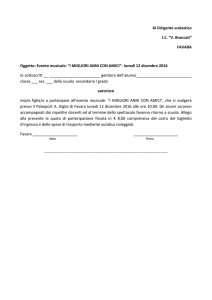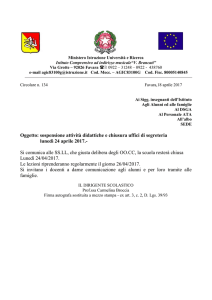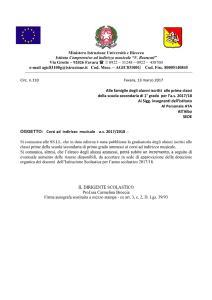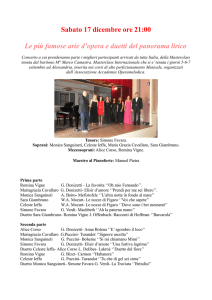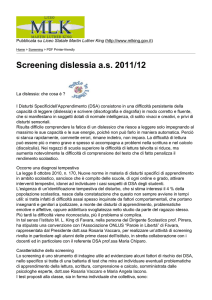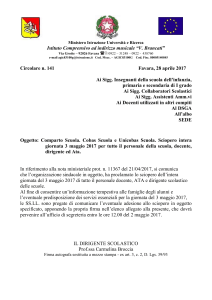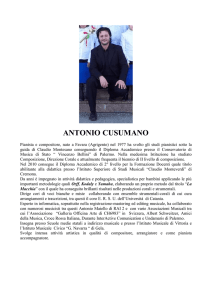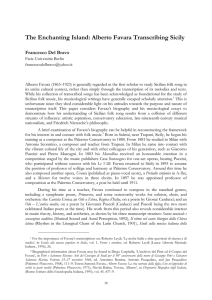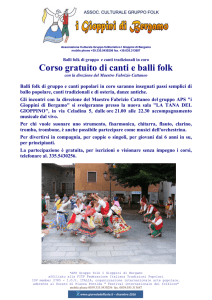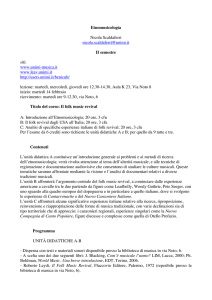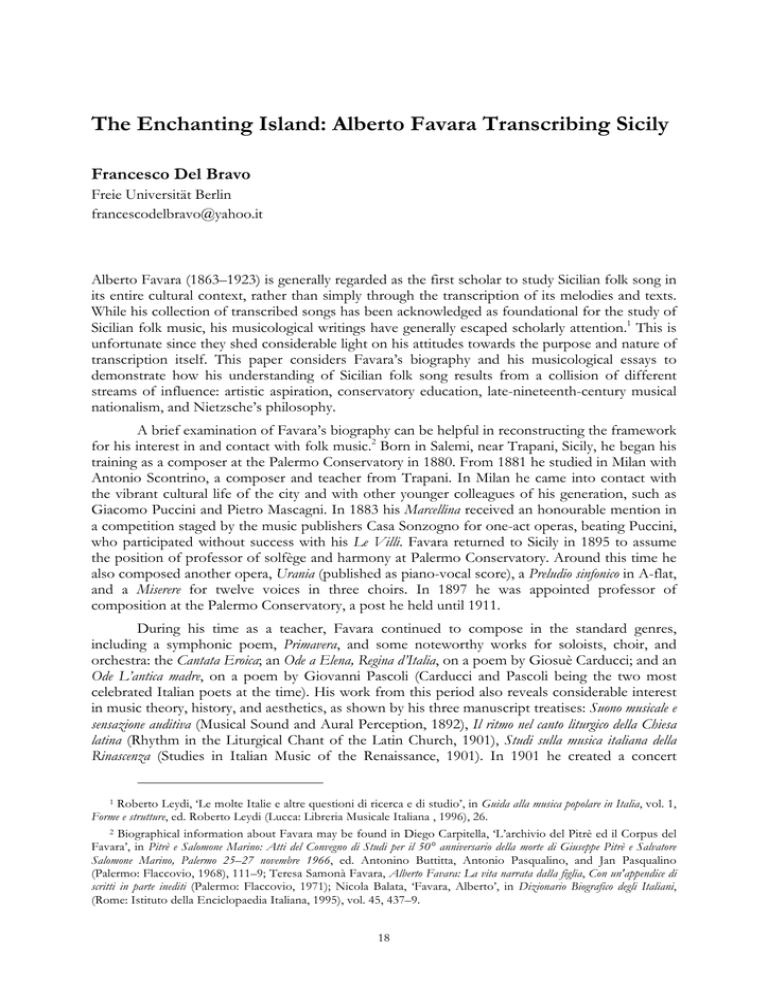
The Enchanting Island: Alberto Favara Transcribing Sicily
Francesco Del Bravo
Freie Universität Berlin
[email protected]
Alberto Favara (1863–1923) is generally regarded as the first scholar to study Sicilian folk song in
its entire cultural context, rather than simply through the transcription of its melodies and texts.
While his collection of transcribed songs has been acknowledged as foundational for the study of
Sicilian folk music, his musicological writings have generally escaped scholarly attention.1 This is
unfortunate since they shed considerable light on his attitudes towards the purpose and nature of
transcription itself. This paper considers Favara’s biography and his musicological essays to
demonstrate how his understanding of Sicilian folk song results from a collision of different
streams of influence: artistic aspiration, conservatory education, late-nineteenth-century musical
nationalism, and Nietzsche’s philosophy.
A brief examination of Favara’s biography can be helpful in reconstructing the framework
for his interest in and contact with folk music.2 Born in Salemi, near Trapani, Sicily, he began his
training as a composer at the Palermo Conservatory in 1880. From 1881 he studied in Milan with
Antonio Scontrino, a composer and teacher from Trapani. In Milan he came into contact with
the vibrant cultural life of the city and with other younger colleagues of his generation, such as
Giacomo Puccini and Pietro Mascagni. In 1883 his Marcellina received an honourable mention in
a competition staged by the music publishers Casa Sonzogno for one-act operas, beating Puccini,
who participated without success with his Le Villi. Favara returned to Sicily in 1895 to assume
the position of professor of solfège and harmony at Palermo Conservatory. Around this time he
also composed another opera, Urania (published as piano-vocal score), a Preludio sinfonico in A-flat,
and a Miserere for twelve voices in three choirs. In 1897 he was appointed professor of
composition at the Palermo Conservatory, a post he held until 1911.
During his time as a teacher, Favara continued to compose in the standard genres,
including a symphonic poem, Primavera, and some noteworthy works for soloists, choir, and
orchestra: the Cantata Eroica; an Ode a Elena, Regina d’Italia, on a poem by Giosuè Carducci; and an
Ode L’antica madre, on a poem by Giovanni Pascoli (Carducci and Pascoli being the two most
celebrated Italian poets at the time). His work from this period also reveals considerable interest
in music theory, history, and aesthetics, as shown by his three manuscript treatises: Suono musicale e
sensazione auditiva (Musical Sound and Aural Perception, 1892), Il ritmo nel canto liturgico della Chiesa
latina (Rhythm in the Liturgical Chant of the Latin Church, 1901), Studi sulla musica italiana della
Rinascenza (Studies in Italian Music of the Renaissance, 1901). In 1901 he created a concert
1 Roberto Leydi, ‘Le molte Italie e altre questioni di ricerca e di studio’, in Guida alla musica popolare in Italia, vol. 1,
Forme e strutture, ed. Roberto Leydi (Lucca: Libreria Musicale Italiana , 1996), 26.
2 Biographical information about Favara may be found in Diego Carpitella, ‘L’archivio del Pitrè ed il Corpus del
Favara’, in Pitrè e Salomone Marino: Atti del Convegno di Studi per il 50° anniversario della morte di Giuseppe Pitrè e Salvatore
Salomone Marino, Palermo 25–27 novembre 1966, ed. Antonino Buttitta, Antonio Pasqualino, and Jan Pasqualino
(Palermo: Flaccovio, 1968), 111–9; Teresa Samonà Favara, Alberto Favara: La vita narrata dalla figlia, Con un'appendice di
scritti in parte inediti (Palermo: Flaccovio, 1971); Nicola Balata, ‘Favara, Alberto’, in Dizionario Biografico degli Italiani,
(Rome: Istituto della Enciclopaedia Italiana, 1995), vol. 45, 437–9.
18
Francesco Del Bravo, The Enchanting Island: Alberto Favara Transcribing Sicily
Mousikos Logos – Issue 2 (January 2015) – ISSN: 1108-6963
society with the aim of involving the conservatory orchestra in the musical life of Palermo by
promoting symphonic music. According to his daughter, Teresa, the idea was not appreciated by
all cultural notables of the city, and he even received threatening letters intended to dissuade him.
Nonetheless, in the same year the Palermitan audience was able to attend the first complete
performance of a Beethoven symphony, the Seventh, at the Teatro Massimo.
Between 1898 and 1905 Favara collected more than 1000 Sicilian songs, mostly in
Palermo and the surrounding area, but also in other districts of Sicily. Travelling at his own
expense around the whole island brought him into contact with cultural and social contexts far
removed from his familiar milieu. Favara was unable to raise sufficient funds to publish the songs
he collected, although he made two attempts during his lifetime: first in 1903, through the
Minister of Education, Vittorio Emanuele Orlando, and later, during the Fascist era, through the
Accademia d’Italia. His collection was, however, published posthumously in 1957. It was edited
by musicologist Ottavio Tiby (who was also Favara’s son-in-law), whose introduction remains the
most important essay on the songbook.3
Although Favara never published the entire collection during his lifetime, he did present
much of his research through his musicological and compositional activities. His four
musicological essays, which originated as conference papers, were edited in a single volume in
1959 by his daughter Teresa.4 As part of that project, he elaborated the folk songs in several new
compositions based upon them. His songs for voice and piano, complete with Italian translations
of the Sicilian texts, were published by Ricordi in two volumes, in 1907 and 1921, with the
evocative title Canti della terra e del mare di Sicilia (Songs of the Earth and the Sea of Sicily). These
were then followed by two more posthumous volumes edited by Tiby in 1954 and 1959.5 The
folk songs also appear in a symphonic work, Sogno in Val d’Enna (1913). The appeal of these
songs is demonstrated by the reaction of Gabriele D’Annunzio, who, upon hearing Favara’s
presentation of some of his Sicilian folks songs in Rome, commissioned him to compose
incidental music for his ‘pastoral tragedy’, La figlia di Iorio (1904), set in the rural and pagan
countryside of Abruzzi.
In 1908 Favara began writing music criticism for the Palermitan newspaper, L’Ora. At the
same time, he began offering private sessions as a singing teacher and speech therapist, parallel to
his teaching activity at the conservatory. In 1911, he travelled with his eldest daughter, Maria, to
Berlin, where he stayed for some months, searching for new career opportunities with concert
performances of his piano-and-voice arrangements of the Sicilian folk songs. He ultimately
returned to Palermo, where he undertook the direction pro tempore of the Conservatory (1911–13),
eventually being replaced by Francesco Cilea. In 1914 he started the revision and the
orchestration of his early opera, Urania, which was performed in 1918 at La Scala, with Tullio
Serafin conducting.
The final period of Favara’s life was marked by poor health and several professional
disappointments at the conservatory. This culminated in the suppression, in 1919, of the course
of performance training that he had created. This was followed in 1921 by a disciplinary action by
the directorate against him because of his health-related absences and his ‘insubordination’ to
Ottavio Tiby, introduction to Alberto Favara, Corpus di musiche popolari siciliane, 2 vols, ed. Ottavio Tiby (Palermo:
Accademia di scienze lettere e belle arti, 1957), vol. 1, 1–113.
4 Alberto Favara, Scritti sulla musica popolare siciliana, ed. Teresa Samonà Favara (Rome: De Santis, 1959).
5 Alberto Favara, Canti della terra e del mare di Sicilia, vol. 1 (Milan: Ricordi, 1907, plate No. 111249), vol. 2 (Milan:
Ricordi, 1921, plate No. 118380). These two volumes have subsequently been republished in a single volume as
Alberto Favara, Canti della terra e del mare di Sicilia (Milan: Ricordi, 1987, plate No. 134349). Ottavio Tiby edited a third
volume on the basis of Favara’s notes (Milan: Ricordi, 1954, plate No. 128543). Tiby also edited a fourth volume
(Milan: Ricordi, 1959, plate No. 129781).
3
19
Francesco Del Bravo, The Enchanting Island: Alberto Favara Transcribing Sicily
Mousikos Logos – Issue 2 (January 2015) – ISSN: 1108-6963
administrative resolutions. Thanks to the intervention of his students, he won his disciplinary
case in 1922. He died the following year.
Favara’s professional troubles seem to reflect tensions over his preoccupations as a protoethnomusicologist and concert promoter, and what would have been regarded as the activities
proper to his status as a composer and conservatory professor. While his promotional work may
not have been entirely out of place, given his profession, his ethnomusicological interest in folk
song could have been seen as an extravagant curiosity, especially compared with the folklorist
approach commonly practiced by composers at that time. Favara’s intellectual fascination with an
other music alienated him from his normal social and cultural environment, taking him into new
territory where he oriented himself according to his established musical knowledge and his search
for new forms of musical expression.
Favara’s Cardinal Points
One may best understand Favara’s conceptual and methodological approach to Sicilian folk song
by considering his four musicological essays, mentioned earlier: ‘Il canto popolare nell’arte’ (Folk
Song in Art, 1898), ‘Le melodie tradizionali di Val di Mazara’ (Traditional Melodies in the Val di
Mazara, 1903), ‘Canti e leggende della Conca d’Oro’ (Songs and Legends of the Conca d’Oro,
1904, first pusblished in 1923), and ‘Il ritmo nella vita e nell’arte popolare in Sicilia’ (Rhythm in
Sicilian Life and Folk Art, 1905, first published in 1923).6
The guiding principle of Favara’s interest in Sicilian folk song lay in his search for a
renewal of Italian national music:
[…] l’artista italiano non ha tempo né disposizione a sentire e intendere quel
canto che nasce spontaneo intorno a lui, quel canto che è la voce legittima
della comunità cui egli appartiene, e ne rivela i sentimenti più profondi e
generali. […] [M]i pare che il canto popolare non abbia ancora esercitato sulla
nostra arte quell’azione salutare e vivificatrice, che per legge di natura egli
deve.7
(The Italian artist has neither time nor disposition to hear and understand
that song which spontaneously emerges around him, that song which is the
legitimate voice of the community of which he is part, and whose song
reveals the deepest and most general feelings. […] It seems to me that folk
song has not yet exerted on our art its healing and vitalizing action, as it
should by the law of nature.)
[…] tutti in Italia aspiriamo ad un’arte nuova; ma per quali vie tortuose ci
siamo noi messi? C’indugiamo dapprima nelle forme esauste di un’arte finita;
poscia ci siamo nutriti fino alla sazietà di una cultura esclusivamente
forestiera, dove non abbiamo potuto rinvenire il nostro accento (ad cantus).8
(In Italy we all aspire to a new art, but on what path are we going? We
lingered first on the exhausted forms of an accomplished art, later we ate our
fill on a totally foreign one, in which we could not find our accent (ad cantus).)
6 All four essays are published in Alberto Favara, Scritti sulla musica popolare siciliana: ‘Il canto popolare nell’arte’,
13–25; ‘Le melodie tradizionali di Val di Mazara’, 26–57; ‘Canti e leggende della Conca d’Oro’, 58–85; and ‘Il ritmo
nella vita e nell’arte popolare in Sicilia’, 86–120.
7 Favara, ‘Il canto popolare nell’arte’, 13. All translations from Favara’s writings are mine.
8 Favara, ‘Il canto popolare nell’arte’, 13-14.
20
Francesco Del Bravo, The Enchanting Island: Alberto Favara Transcribing Sicily
Mousikos Logos – Issue 2 (January 2015) – ISSN: 1108-6963
[…] la nuova Rinascenza italiana, che ad un sistema di conoscenza esteriore
viene sostituendo la caldura delle nostre energie innate, non deve lasciar
morire nell’oblio la millenaria esperienza melodica di nostra gente; poiché qui
solamente essa troverà, dopo il cieco vagolare fra mille stili e tendenze, il
principio e la via di quel rinnovamento musicale e drammatico, cui tutti
aspiriamo.9
(The new Italian Renaissance, which is substituting the heat of our innate
energies with a superficial knowledge system, must not let the thousands-ofyears-old melodic experience of our people die in oblivion; only in this will it
find, after blind wandering among thousands of styles and tendencies, the
starting point and path for the musical and dramatic renewal for which we are
striving.)
[…] buttar via con un crollo di spalle tutto ciò che della nostra lunga storia
non serve a farci raggiungere un più grande avvenire, ed aprire le porte dei
Conservatori agli elementi vivificanti dell’arte popolare e a quella cultura del
ritmo e della melodia che rinnoverà la nostra situazione musicale. Ma
anzitutto occorre il lavoro paziente e sagace del folklorista, cui spiri dentro il
puro amore dell’arte del luogo natio.10
(Throwing away all that is not useful to reach a great future, and opening the
doors of our conservatories to the enlivening elements of folk art and to the
culture of rhythm and melody: that will renew our musical situation. But
above all is required the patient and insightful work of folklorists, internally
inspired by true love for the art of the native place.)
Favara’s observations about folk music are clearly part of the European nationalistic mentality of
his time. In his quest for a regeneration of national music through a rediscovery of its roots, both
sophisticated and ethnic, he was intent on avoiding ‘decadent’ and ‘foreign’ influences. His
reference to a ‘new Renaissance’ indicates markedly how his approach to Sicilian folk music was
indeed inscribed in a cultural framework oriented toward a glorious Italian past that stretched
back to antiquity.
Favara’s rejection of contemporary musical culture also reflected a stigmatization of the
false Sicilian folklore promoted by verismo operas and salon song collections. The salon songs, in
particular, often presented as ‘folk’ songs, were in fact adapted to an idealized form of Sicilian
folk music cast as simple strophic songs with recurring melodies and rhythms, and the most
elementary tonal harmonies. These characteristics are evident, for example, in the song Ciuri, ciuri
(Figure 1), from the 1883 collection of Sicilian folk songs, Eco della Sicilia, arranged for voice and
piano by Favara’s Sicilian contemporary, Francesco Paolo Frontini (1860–1919).11
Favara, ‘Canti e leggende della Conca d’Oro’, 83.
Favara, ‘Canti e leggende della Conca d’Oro’, 85.
11 Francesco Paolo Frontini, Eco della Sicilia, cinquanta canti popolari siciliani (Milan: Ricordi, 1883, plate No. 49137).
9
10
21
Francesco Del Bravo, The Enchanting Island: Alberto Favara Transcribing Sicily
Mousikos Logos – Issue 2 (January 2015) – ISSN: 1108-6963
Figure 1. Ciuri, ciuri, from Francesco Paolo Frontini, Eco della Sicilia, cinquanta canti popolari siciliani
(Milan: Ricordi, 1883; plate no. 49137).
22
Francesco Del Bravo, The Enchanting Island: Alberto Favara Transcribing Sicily
Mousikos Logos – Issue 2 (January 2015) – ISSN: 1108-6963
The origins of this kind of music may be traced to Italian urban music culture, in which
operatic and folk music had coexisted for centuries. By the nineteenth century, they had partially
merged together, most recognizably in the Neapolitan song.12 Favara plainly expressed his
unfavourable opinion of such ‘folk’ songs:
Guardando difatti alla complessiva produzione musicale odierna, non vi si
scorge influenza o traccia alcuna di elementi popolari. Intendo: non la
riproduzione o l’imitazione del canto popolare, come nel melodramma, dove
la situazione scenica ne dà l’opportunità, o come la falsa rifioritura del canto
popolare di Piedigrotta, e poscia, per imitazione, anche fra noi e altrove; ma
una influenza più intima e profonda del canto del popolo sul canto
dell’artista, un’influenza che non si Libreria Musicale Italianaiti ai caratteri
esteriori, ma scenda, non per forza di analisi ma di sentimento, nei più
reconditi misteri della bellezza melodica.13
(In fact, surveying the current overall music production, no trace or influence
of folk elements can be detected in it. [I am not referring] to the reproduction
or imitation of folk song as [is found] in opera, when the dramatic situation
gives the chance for it, or in the false revival of folk song in Piedigrotta
[Naples], and afterwards, by imitation, even among us [in Sicily] and
elsewhere, but a more intimate and deep influence of folk song on the artist’s
song; an influence that is not limited to external features, but that descends,
not by analysis but by feeling, in the most hidden mysteries of melodic
beauty.)
Buon numero di canti che ci dà il Frontini sono apocrifi, non hanno di
popolare che la veste, in alcuni ci è perfino il nome dell’autore; e non sono
naturalmente i più belli! Il Frontini addossò loro un accompagnamento di
pianoforte, che quasi sempre deturpa il canto. Il canto popolare, nato vergine
di armonia polifonica, perde, se lo si accompagna, la sua libera andatura, la
sua originale fisionomia; tutt’al più può sopportare i semplici e tranquilli
accordi, o la riproduzione fedele nello strumento del suo giro melodico. . . .
[A]ltre raccolte sono senza accompagnamento, e per ciò migliori; ma vi è pur
lì la tendenza di togliere al canto la sua forma ritmica naturale, per
costringerlo a muoversi fra le stanghette della nostra misura moderna.14
(A great number of songs gathered by Frontini are apocryphal; their folk is
just a robe. Some of them even bear the name of the author and obviously these
are not the most beautiful! The folk song – which emerged without any mark
On the relationship between Italian opera and folk culture see Roberto Leydi, ‘Diffusione e volgarizzazione’, in
Storia dell’opera italiana, vol. 6, Teorie e tecniche, immagini e fantasmi, ed. Lorenzo Bianconi and Giorgio Pestelli (Turin:
Edizioni di Torino, 1988), 301–92; Marcello Sorce-Keller, “‘Gesunkenes Kulturgut” and Neapolitan Songs: Verdi,
Donizetti, and the Folk and Popular Tradition’, in Atti del XIV Congresso della Società Internazionale di Musicologia,
Trasmissione e recezione delle forme di cultura musicale, vol. 3, Free Papers, ed. Angelo Pompilio, Donatella Restani, Lorenzo
Bianconi, and F. Alberto Gallo (Turin: Edizioni di Torino, 1990), 401–5. On the relationship between opera and
Neapolitan song see Ignazio Macchierella, ‘Le “Canzoncine Popolari Napoletane” dei “Passatempi musicali”: una
“piccola tradizione” della musica’, in Una piacente estate di San Martino. Studi e ricerche per Marcello Conati, ed. Marco
Capra (Lucca: Libreria Musicale Italiana, 2000), 59–76; Giorgio Ruberti, ‘Canzoni all’Opera: melodramma e musica
napoletana tra Otto e Novecento’, in La canzone napoletana: Le musiche e i loro contesti, ed. Enrico Careri and Anita Pesce
(Lucca: Libreria Musicale Italiana, 2011), 32–52.
13 Favara, ‘Il canto popolare nell’arte’, 13.
14 Favara, ‘Il canto popolare nell’arte’, 21.
12
23
Francesco Del Bravo, The Enchanting Island: Alberto Favara Transcribing Sicily
Mousikos Logos – Issue 2 (January 2015) – ISSN: 1108-6963
of polyphonic harmony – loses its original physiognomy if it is accompanied;
it can carry at the most the simplest and smoothest chords or the faithful
reproduction of its melodic outline. […] Other collections are without
accompaniment, and therefore better, but they also show the tendency to
deprive the song of its natural rhythmic form in order to confine it between
the bar lines of our modern meters.)
Favara’s attention to the original performance of the folk songs as the necessary basis for
understanding them implicitly brought him into opposition with Giuseppe Pitrè (1841–1916). A
Palermitan physician and researcher who spent his entire life studying Sicilian folklore, Pitrè
edited, from 1871 to 1913, a twenty-five-volume encyclopaedia on Sicilian folk traditions
(Biblioteca delle tradizioni popolari siciliane) and founded an ethnographic museum in his city.15
Among his noteworthy achievements is his edition, in 1870–71, of a two-volume collection of
Sicilian folk songs, Canti popolari Siciliani.16 Despite its title, the collection consists primarily of
poetic texts rather than songs, which Pitrè ordered on the basis of their genre, theme, and
occasion. Pitrè’s aim was not only to gather the treasure of Sicilian folk poetry, but also to
inscribe it in the national literary canon. This would allow him to claim for Sicilian the status of a
literary language and a powerful poetic resource, probably with a view to re-establishing the lost
supremacy of the Sicilian School:17
Parlo di vergine fantasia e d’intelligenza priva d’ogni coltura, i canti che le
scuole non degnano d’uno sguardo, ma che le scuole non sanno fare,
racchiudono tanto tesoro di affetti, tanta copia di pensieri e d’immagini che a
saperli parcamente imitare, ogni studioso, dal men facile verseggiatore al più
ispirato poeta, ne ritrarrebbe bellezze inestimabili.18
(I speak of a virgin fantasy and of an intelligence devoid of any culture, the
songs that schools do not deign to look at, but that schools cannot make;
they contain such a treasure of affections, such an abundance of thoughts and
images that any scholar, from the least talented versifier to the most inspired
poet, who would sparingly imitate them, could elicit from them inestimable
beauties.)
He was aware of the distance between the transcribed poetry of his collection and the sung
poetry performed by Sicilian people, noticing how
Il canto o meglio la parola non isposata alla melodia non è l’espressione
intiera della poesia veramente popolare. La melodia ha un grandissimo ufficio
nel canzoniere del popolo: senza la quale il canto è un puro ed ozioso
esercizio; ecco perché s’incontrano gravi difficoltà nel raccogliere e copiare
de’ canti colla sola ripetizione orale di chi li sa, e perché volendoli avere nella
loro interezza bisogna che il cantatore associi la musica alla poesia.19
(Song, or better, word not married to melody, is not the full expression of
true folk poetry. Melody plays an important role in the folk song book:
15 For a general introduction to Giuseppe Pitrè, see Giovanni Battista Bronzini, Orizzonte folklore: l’opera di Giuseppe
Pitrè (Palermo: Ila Palma, 1989).
Giuseppe Pitrè, Canti popolari siciliani, 2 vols (Palermo: Luigi Pedone Lauriel, 1870‒71).
On the Sicilian School (scuola siciliana), see Gianfranco Folena, ‘Cultura e poesia dei Siciliani’, in Storia della
Letteratura Italiana, vol. 1, Le origini e il Duecento, ed. Emilio Cecchi and Natalino Sapegno (Milan: Garzanti, 1987),
291–372; Ignazio Baldelli, ‘Dai siciliani a Dante’, in Storia della lingua italiana, vol. 1, I luoghi della codificazione, ed. Luca
Serianni and Pietro Trifone (Turin: Einaudi, 1993), 581–89.
18 Pitrè, Canti popolari siciliani, vol. 1, 173. All translations from Pitrè’s writings are mine.
19 Pitrè, Canti popolari siciliani, vol. 1, 45.
16
17
24
Francesco Del Bravo, The Enchanting Island: Alberto Favara Transcribing Sicily
Mousikos Logos – Issue 2 (January 2015) – ISSN: 1108-6963
without it song is a simple and useless exercise; this is why great difficulties
occur in gathering and transcribing songs from the mere oral repetition of
people who know them and why, if we want to get them in their entirety, the
singer must relate the music to the poetry.)
The terminological confusion between song-as-poetry (the word not married to the
melody) and song-as-sung-word was not merely the consequence of the traditional overlap
between the terms used for poetry and song (carmen, chanson, canzone, etc.). It signalled Pitrè’s
underlying assumption that folk song was primarily orally-transmitted poetry, and thus had to be
transcribed to obtain texts readable and analysable according to the rules of written poetry. His
acknowledgment of the importance of melody and voice for folk singers in defining the object
‘song’ led him, however, to append thirty-two transcribed melodies in the second volume of his
collection, in order to provide an idea of some recurring melodic models in Sicilian folk song. As
he illustrates in his very short introduction to this appendix, the melodies were not gathered and
transcribed by him, as he did not have any music education. Instead, they were compiled by
various Sicilian scholars and musicians who were interested in folk poetry.20 Paraphrasing Favara,
we may observe that all the melodies are notated by confining them within the bar lines of
standard meters. As Diego Carpitella remarks, comparing Pitrè’s melodies with those that Favara
also transcribed, many of Pitrè’s seem to have been changed to conform to abstract models of
melodic and rhythmic regularity.21
Favara’s aforementioned attack on Frontini’s transcribing method may have also been
directed at Pitrè’s collection. After all, Pitrè had been Frontini’s professor of Italian literature at
the Palermo Conservatory and later wrote a eulogistic foreword to Frontini’s posthumously
published folk song collection.22 In any case, Favara was more direct and extreme in his criticism
of Pitrè’s prioritization of the literary text in his approach to Sicilian folk songs, although he does
not mention the Palermitan folklorist by name:
Il contadino suddivide il suo canto in membri di frase, in ognuno dei quali
pone un solo accento melodico; nel membro di frase le combinazioni ritmiche
sono infinite, e l’accento melodico può trovarsi in qualunque punto della sua
estensione. […] Parmi che questo criterio dovrebbe anche adattarsi nel
trascrivere le parole del canto popolare. […] Nelle raccolte finora pubblicate,
le parole sono disposte secondo le forme e gli artifici della versificazione
parlata, numero di sillabe, accento di intensità, rima. Avviene poi,
precisamente come nei libretti d’opera, che queste forme e questi artifici nella
frase melodica spariscano e si trasformano, perché non corrispondono al vero
ritmo del canto popolare, vivente nell’intima compenetrazione della musica e
della parola.23
(The peasant subdivides his song in phrase components, putting only one
melodic accent in each of them; in each phrase component the rhythmical
combinations can be countless, and the melodic accent can appear at any
point of the phrase component’s span. […] It seems to me that this criterion
should also be used in transcribing the words of folk song. […] In the
Pitrè, Canti popolari siciliani, vol. 2, vii.
Carpitella, ‘L’archivio del Pitrè ed il Corpus del Favara’, 114–15.
22 On the relationship between Pitrè and Frontini, see Carmelina Naselli, ‘Giuseppe Pitrè, la musica popolare e il
carteggio inedito col maestro F. P. Frontini’, in Pitrè e Salomone Marino: Atti del Convegno di Studi per il 50° anniversario
della morte di Giuseppe Pitrè e Salvatore Salomone Marin, Palermo 25‒27 novembre 1966, ed. Antonino Buttitta, Antonio
Pasqualino, and Jan Pasqualino (Palermo: Flaccovio, 1968), 269‒88.
23 Favara, ‘Il canto popolare nell’arte’, 22.
20
21
25
Francesco Del Bravo, The Enchanting Island: Alberto Favara Transcribing Sicily
Mousikos Logos – Issue 2 (January 2015) – ISSN: 1108-6963
collections published until now, the words are disposed according to the
forms and artifices of spoken poetry: syllable number, stress accent, and
rhyme. It happens then, as in opera libretti, that such forms and artifices
disappear in the melodic phrase and transform themselves, as they do not
correspond to the true rhythm of folk song, which resides in the intimate
relationship between music and word.)
We can thus understand how Favara’s radically different approach to Sicilian folk music might
have been interpreted as an act of lèse-majesté against the Palermitan authority on folklore studies.
This may have played a role in his conflicts with the cultural circles of the city, which eventually
led to his intellectual and professional isolation.
Analysing folk songs through performance allowed Favara to discover some general
principles of how their texts were conceived and structured:
[…] la composizione poetica sotto l’influenza diretta della musica si sviluppa
in magnifiche e strane forme speciali: una serie non interrotta di immagini che
si legano fra di loro nella sensazione, al di fuori del nesso logico, come i suoni
succedentisi di una melodia; un ordine ascendente dalla emozione presente
verso le immagini lontane; una sintassi libera, che ha tutti i caratteri della
improvvisazione; una grande ricchezza di parole arcaiche, nella cui scelta la
sonorità ha una grande importanza.24
(The poetic composition, under the direct influence of the music, develops
toward magnificent and strange special forms: a continuous series of images
linked through their feelings, outside of a logical connection, like sounds
following each other in a melody; an ascending order from the current
emotion to ancient images; a free syntax with all the features of
improvisation; a great richness of archaic words, chosen mostly for their
sonority.)
La verità è che nella nostra canzone il ritmo non riposa affatto sull’accento
d’intensità della parola e sul numero delle sillabe, ma esclusivamente
sull’elemento musicale, che nella produzione lirica naturale è già fissato prima
che la parola venga a unirglisi. In questa unione la lingua parlata, sotto la
prepotente influenza della musica, rinunzia a tutte le sue rigide articolazioni,
per adattarsi docilmente alla forma ritmica della melodia. Così abbiamo
Trapàni invece di Tràpani, vuccà invece di vùcca, e molti altri spostamenti di
accento. La lingua lirica rinuncia financo all’unità delle parole, che vengono
spezzate dal respiro fra l’uno e l’altro membro di frase. Sicché l’endecasillabo
e l’ottava rima non sono che forme ritmiche apparenti; il ritmo reale è nel
canto.25
(The truth is that in our songs the rhythm absolutely does not rest on the
stress accent of the word and syllabic count, but solely on the musical
element, in which the natural formation of the lyric is established before the
word is joined to it. In this unity the spoken language, under the powerful
effect of music, renounces its rigid rules of articulation, humbly adapting
itself to the rhythmic form of the melody. Thus we have Trapàni in place of
Tràpani, vuccà in place of vùcca [mouth], and other shifts of stress accents. The
lyric language even renounces the unity of words, which are broken into two
24
25
Favara, ‘Le melodie tradizionali di Val di Mazara’, 44.
Favara, ‘Le melodie tradizionali di Val di Mazara’, 43–4.
26
Francesco Del Bravo, The Enchanting Island: Alberto Favara Transcribing Sicily
Mousikos Logos – Issue 2 (January 2015) – ISSN: 1108-6963
phrase components by the breath. Therefore, the hendecasyllable and the
ottava rima are mere illusory rhythmic forms; the real rhythm is in the song.)
According to Favara, then, words in Sicilian folk song are rhythmically structured, even reformed,
according to the melody they are joined to, and not, as in Pitrè’s conception, simply adapted to it.
Nor do the texts adapt an existing melody to themselves. Furthermore, the words possess more
than their simple semantic meaning, being selected because of their vocal sound and their link to
an ancient world. In other words, for Favara the enunciation of a folk song’s text has a sort of
magical effect, which explains why performance is such an important determinant of the poiesis
and the analysis of the song.
Favara relates the proper performance of the words to his general historical reflections on
language and poetry:
[…] la versificazione moderna e la forma lirica rispondono a due stati
profondamente diversi della lingua, il dialetto e la lingua letteraria. Il dialetto è
il principio del cammino intrapreso dalla lingua verso l’astrazione; esso è in
immediato contatto con la natura, e quindi impregnato ancora delle cose. Il
dialetto conserva nelle sue vocali la modulazione musicale primitiva; nella
parola una vocale proferita con una intonazione più acuta dà l’accento
melodico, il vero ad cantus […] la durate delle sillabe è realmente variabile. […]
Ma nel progresso verso l’astrazione, l’uomo trasformò gradatamente la lingua,
fino a ridurla un rigido ed affilato strumento delle più raffinate analisi. La
lingua dialettale si disseccò; la durata delle sillabe diventò uguale o quasi, la
ricca sonorità delle vocali si perdette, la parola non fu più sostenuta da una
forma melodica, ma dal rinforzo eccessivo di una sillaba che raggruppa
intorno a sé le altre, l’accento di intensità; così il nostro discorso può ben
paragonarsi alla lunga serie di piccoli colpi, prodotti da una macchina
telegrafica.26
(The modern versification and forms of lyric poetry comply to two deeply
different states of language, i.e. the dialect and the literary language. The
dialect is the beginning of the path taken by language toward abstraction; it is
in direct contact with nature and therefore already impregnated by things.
The dialect maintains in its vowels the primitive musical intonation; in each
word a vowel pronounced with a higher inflection gives the melodic accent,
the true ad cantus […] syllable length is quite variable. […] During the
progress toward abstraction, humans gradually transformed the language,
eventually reducing it to a rigid and sharp device for the most refined analysis.
The dialectal language dried up: syllable length became always or almost
always the same; the rich sonority of vowels was lost; the word was no more
sustained by a melodic form, but by excessive reinforcement of the syllable
around which all the others are clustered, the stress accent; our speech can be
compared to the long series of little bangs produced by telegraph machines.)
Such emphasis on dialect as a joining link between material nature and abstract language was
connected with a deep admiration for Greek lyric poetry, which appeared to Favara as the ethnic
root of Sicilian dialect and the aim of the renewal of Italian music that for which he was
searching:
O beati tempi dei lirici greci, beati i tempi della lirica dorica, della eolia, della
lirica tragica, l’inno più bello che sinora l’umanità abbia cantato! […] E se noi,
26
Favara, ‘Il canto popolare nell’arte’, 18–19.
27
Francesco Del Bravo, The Enchanting Island: Alberto Favara Transcribing Sicily
Mousikos Logos – Issue 2 (January 2015) – ISSN: 1108-6963
noi tornassimo alla lirica dialettale? Noi, che ancora un resto di sangue ellenico
dobbiamo pure averlo nelle vene? Qual sogno!... Dal dialetto al canto il passo
è breve, non vi è interruzione, sono due stati vicini dell’evoluzione.27
(Oh happy days of Greek lyric poets, happy days of Dorian lyric, of the
Aeolian, of tragic lyric, the most beautiful hymn never sung by humankind
[…] And what if we […] return to the dialectal lyric? We who must still have a
remnant of Hellenic blood in our veins? What a dream! […] From dialect to
song is a short step, there is no interruption, they are two close states of the
evolution.)
The association of specific Greek lyric poetry with ancient Greek musical modes (Dorian,
Aeolian) seems to be for Favara not simply a suggestive cultural connection between Sicily and
the ancient Greek colony that belonged to the Megáli Ellás, or Magna Graecia. As Tiby remarks,
the melodies were never transcribed in their absolute pitch but in abstract scalar systems, usually
centered on D, E, or F, which, he explains, satisfied practical concerns for convenience and
speed.28 Recognizing with Tiby that the most common modes in the song collection are DDorian, F-Lydian, and E-Phrygian reveals how Favara’s connection of Sicilian folk song to
ancient Greek lyric poetry constituted the musicological filter through which he heard and
transcribed the songs.29 We should remember that while he was collecting his folk songs, the
basic work of François-Auguste Gevaert, whom Favara includes in a list of ‘modern Hellenists’,
had already been published.30 Indeed, the assumed link between Sicilian folk song and Greek
modes had been a topic of scholarly discussion for decades, which itself rested upon an even
older discourse reaching back to the eighteenth century.31
Favara’s various claims about (1) folk poetry as song, (2) folk language or dialect as a link
between nature and abstraction, (3) melody as the organizing principle for poetic rhythm,
accentuation, phraseology, and verbal syntactical construction, and (4) ancient Greek lyric poetry
as a basis for analysis and critical interpretation of folk song all bear obvious debt to Nietzsche’s
The Birth of Tragedy Out the Spirit of the Music, first published in 1872.32 Favara explicitly
acknowledges Nietzsche as the philosophical inspiration for his folk song collection. For
example, writing about the furnarisca, a melodic type found in many of the Palermitan songs,
Favara observes how
Il popolano di Palermo canta sulla furnarisca tutte le sue canzoni d’amore e di
sdegno, del più vario contenuto poetico; ma la cantilena, che insieme al
dialetto proviene da condizioni etniche, organiche e psichiche che stanno nel
Favara, ‘Il canto popolare nell’arte’, 20.
Favara, Corpus di musiche popolari siciliane, 10.
29 Favara, Corpus di musiche popolari siciliane, 30.
27
28
François-Auguste Gevaert, Histoire et théorie de la musique de l'antiquité, 2 vols (Gand: Annot-Braeckman, 1875‒
81). Favara’s list appears in ‘Il canto popolare nell’arte’, 20.
31 For a general overview see Harold Powers, ‘Modality as a European Cultural Construct’, in Atti del secondo
convegno europeo di analisi musicale, vol. 1, ed. Rossana Dalmonte and Mario Baroni (Trento: Università degli Studi di
Trento, 1992), 207–19. For more on Sicilian folk songs see Ettore Romagnoli, ‘I canti popolari siciliani e la musica
greca’, in Favara, Scritti sulla musica popolare siciliana (1920, rpt. 1959), 130–49; Paul Collaer, ‘I modi della musica
tradizionale siciliana’, in Culture musicali 2 (1982), 3–18. For the earlier discourses see Bruno Bossis, ‘Sources
populaires et compositions de l’érudition au génie créateur: L’exemple de mélodies grecques chez BourgaultDucoudray et Ravel’, in Ostinato Rigore 24 (2006), 219–42; Inga Mai Groote, ‘Griechische Bretonen? Hintergründe
und Funktionen der Modalität bei Louis-Albert Bourgault-Ducoudray’, in Musiktheorie 29 (2014), 5–15; Matthew
Gelbart, The Invention of ‘Folk Music’ and ‘Art Music’: Emerging Categories from Ossian to Wagner (Cambridge: Cambridge
University Press, 2007), 111–52.
32 Friedrich Nietzsche, The Birth of Tragedy: Out of the Spirit of Music, trans. Shaun Whiteside (Harmondsworth:
Penguin, 1993).
30
28
Francesco Del Bravo, The Enchanting Island: Alberto Favara Transcribing Sicily
Mousikos Logos – Issue 2 (January 2015) – ISSN: 1108-6963
fondo del suo essere, rimane sempre invariabile. Ognuno può constatare da
sé, non solo a Palermo e per la furnarisca, ma dovunque il popolo canti, il
doppio fenomeno: la immanenza della cantilena locale e le varie
oggettivazioni poetiche che se ne irradiano. Questo fenomeno, che io ho
potuto osservare costantemente nelle mie lunghe ricerche del canto popolare
in Sicilia, l’osservò Federico Nietzsche nel canto popolare di Germania, e lo
spiegò, come non si potrebbe meglio, nel paragrafo 6 della sua originalissima
opera giovanile L’Origine della tragedia.33
(The people of Palermo sing all their songs of love and disdain on the
furnarisca, songs mostly different in content but whose melody – which, as
with the dialect, comes from ethnic, organic, and psychic conditions residing
in a human’s deepest being – always remains invariable. Not only in Palermo
for the furnarisca, but everyplace where the folk sing [there is] a double
phenomenon [that] can be verified by everyone: the immanence of a local
melody and the different poetic objectifications radiating from it. This
phenomenon, which I could continuously observe during my extended
researches on Sicilian folk song, was observed by Friedrich Nietzsche in
German folk song, and he best explained it in the sixth section of his early,
totally unconventional work, The Birth of Tragedy.)
Indeed, the sixth section of The Birth of Tragedy does contain passages corresponding to Favara’s
broad reflections on folk song. Drawing a distinction between ‘Apollonian’ epic poetry, centred
on words and images, and ‘Dionysian’ lyric poetry, centred on song, Nietzsche states:
Melody, then, is both primary and universal, which is why it can therefore bear
various objectifications in various texts. It is also more important and
necessary by far in the naïve estimation of the people. Melody gives birth to
poetry, over and over again; this is precisely what the strophic form of the folk song
tells us. […] In the poetry of folk song, then, we see language doing its
utmost to imitate music. […] [I]mbued with music’s power, the word, the image
and the concept seek an expression analogous to music. In this sense we can
distinguish two main currents in the linguistic history of the Greek people.
We need only consider the linguistic differences in colour, syntactical
construction and phraseology in Homer and Pindar to understand the
meaning of this opposition.34
Favara’s daughter, in her biography of her father, confirmed his commitment to
Nietzsche, whom he first read in French translation and subsequently in the original German.35
No wonder, then, that the cover page of the first volume of Canti della terra e del mare di Sicilia
(1907) features a reference to the sixth section of The Birth of Tragedy: ‘Seguendo Archiloco. F.
Nietzsche. L’Origine della Tragedia, 6’ (Following Archilocus. F. Nietsche. The Birth of Tragedy,
6). Archilocus is the poet whom Nietzsche recognizes as having introduced folk song in
literature:
As regards Archilocus, learned research has revealed that he introduced folk
song into literature, and that for this deed he was accorded his unique place
beside Homer in the universal estimation of the Greeks.36
Favara, ‘Canti e leggende della Conca d’Oro’, 60.
Nietzsche, The Birth of Tragedy, 33.
35 Teresa Samonà Favara, Alberto Favara, 26.
36 Nietzsche, The Birth of Tragedy, 32.
33
34
29
Francesco Del Bravo, The Enchanting Island: Alberto Favara Transcribing Sicily
Mousikos Logos – Issue 2 (January 2015) – ISSN: 1108-6963
Favara apparently regarded his voice and piano arrangements as fulfilling a similar role for Sicilian
folk song by incorporating it into Italian cultivated music in order to renew it.
Favara’s immersion in folk song brought to his attention its distinctive rhythmic element,
which he initially regarded belonging to a sort of folk Gesamtkunstwerk comprising gesture,
melody, and language, to which he later added natural and cosmic forces:
Non si può, senza violenza, distaccare nell’arte popolare la musica dal gesto e
dalla lingua; sono le tre arti del movimento; nate insieme da un unico impulso
inconscio. Possiamo sorprendere il fenomeno dell’individuo fortemente
eccitato da sinergiche sensazioni; è allora che avvengono in lui forti
contrazioni muscolari che si risolvono nel canto, nella mimica e nella parola.37
(In folk art it is not possible, without violence, to detach music from gesture
and language; they are the three arts of movement, born from a single
unconscious impulse. We can detect this phenomenon in a person intensely
excited by synergetic sensations; it is in this moment that strong muscular
contractions occur in him, then resolving in song, mimicry, and word.)
Sapevo che vi è un determinismo meccanico del movimento, una legge di
meccanica applicata che determina la struttura organica delle specie animali,
secondo i movimenti necessari alla loro vita e alla loro conservazione. […]
Sapevo ancora che il ritmo è la legge costante delle nostre azioni muscolari e
quindi dei nostri movimenti […] Tutto ciò al di fuori della volontà, la quale
non può regolare il ritmo, non avendo in sé la nozione della durata. […] Mi
diedi allora ad osservare il fenomeno ritmico fuori di me, nel mondo
oggettivo che mi circondava, e a prenderne nota. Mi è riuscito, così, di
sorprendere nell’ampia distesa del latifondo siciliano tutta una serie di
manifestazioni elementari del ritmo.38
(I knew that a mechanical determinism of movement exists, a law of applied
mechanics determining the organic structure of animal species on the basis of
the movements needed for their life and preservation. […] I knew also that
rhythm is the constant law of our muscular actions and thus of our
movements […] All this happens outside of the will, which cannot regulate
rhythm, having no notion of duration […] I then began to observe the
rhythmical phenomenon outside of myself, in the objective world
surrounding me, taking note of it. Thus, I was able to capture a whole series
of basic rhythmical manifestations in the wide expanse of the Sicilian
countryside.)
For Favara, the transition from an idea of rhythm centred in the human body and linked with
emotions to one of rhythm embedded in the world and linked with cosmic, organic laws
provided a stable reference to Greek antiquity, which remained his basis for interpreting
observed phenomena. Thus, for example, Favara claims to ‘discover’ a connection between the
rhythmical movements of participants in a procession in Salemi, similarly organized rhythmical
movements of his daughter dancing and jumping, and the long-short-long Cretic poetic foot
39
(–∪–) of Aristophanes’s comedies.
Favara, ‘Il canto popolare nell’arte’, 15–16.
Favara, ‘Il ritmo nella vita e nell’arte popolare in Sicilia’, 86.
39 Favara, ‘Il ritmo nella vita e nell’arte popolare in Sicilia’, 105–8.
37
38
30
Francesco Del Bravo, The Enchanting Island: Alberto Favara Transcribing Sicily
Mousikos Logos – Issue 2 (January 2015) – ISSN: 1108-6963
Favara’s claims regarding the connection of Sicilian folk song with Antiquity, based on his
hyper-Nietzschean thought, eventually led to a blurred association of Sicilian folk rhythms, Greek
cosmogonic myth, and Sicilian natural phenomena:
Dal ditirambo arriviamo, infine, al mito dove sono le origini del ritmo;
quando Dionisio [sic] Zagrèo fu dilaniato dai titani, si ruppe l’unità
primordiale del mondo, e dagli spasimi del Dio morente nacquero le forme
della vita. Gli antichi ponevano una divinità al posto di un fenomeno, e il
culto di questa divinità era la figurazione del fenomeno stesso, i cui moti si
trovavano riflessi nella rappresentazione. Così, nel culto dionisiaco i ritmi di
genere doppio erano una riproduzione diretta dei fenomeni tellurici, della
formazione e della distruzione catastrofica dei mondi. […] In questa nostra
terra la tragedia tellurica si ripete periodicamente nei secoli, rinnovando in noi
il senso docmiaco della vita; il ditirambo qui è sempre vivo, coi suoi ritmi usciti
dalle viscere stesse della terra scossa e Travolta. […] L’opposizione tra ritmi
di genere pari e quelli di genere doppio non è, dunque, solamente una
questione di metrica, ma è nella vita stessa, nella dinamica delle cose; è
l’opposizione tra i due mondi dello spirito e della materia, tra il cielo e la terra,
tra Apollo e Dionisio [sic].40
(From dithyramb we reach, eventually, the myth in which resides the origins
of rhythm; as Dionysus Zagreus was torn to pieces by the Titans, the
primordial unity of the world was broken, and all the forms of life came into
the world from the spasms of the dying god. The ancients put a goddess in
place of a phenomenon, and the cult of this goddess was the representation
of the phenomenon as itself because its motions were reflected in the
representation. Thus, in the Dionysian cult the compound rhythms were a
direct reproduction of the telluric phenomena, of the formation and
catastrophic destruction of world. […] In our land the telluric tragedy keeps
recurring periodically through the centuries, renewing our dochmiac sense
[∪– – |∪ –] for life; the dithyramb here is still alive, with its rhythms coming
out of the bowels of the earth, quaked and devastated. […] The opposition
between simple and compound rhythms it is not, then, only a metrical matter;
it resides in life itself, in the dynamics of the world; it is the opposition
between the spiritual and material world, between heaven and earth, between
Apollo and Dionysus.)
Favara’s Thick Evocations
Particularly interesting are the descriptions Favara made of some songs to explicate and interpret
the context in which they emerged, were performed, and collected by him. Favara does not
present this context as a mere social setting, but as a special dimension specifically suited to
embody the connectedness of the folk singers and the scholar who seeks to transmit their spirit.
This is apparent in Favara’s discussion of Nota di li lavannari (Aria of Laundresses).41 Figure 2
shows his original transcription of this song, which he discusses in his second musicological essay
under the title Modo della Chianta (no. 293 in the Tiby edition). Figure 3 presents the first page of
Favara, ‘Il ritmo nella vita e nell’arte popolare in Sicilia’, 116.
Favara’s use of the term nota here is somewhat imprecise, but an acceptable free translation would be ‘way of
singing’. Lavannari is Sicilian dialect for laundresses, or, more generally, any women doing their laundry.
40
41
31
Francesco Del Bravo, The Enchanting Island: Alberto Favara Transcribing Sicily
Mousikos Logos – Issue 2 (January 2015) – ISSN: 1108-6963
his arrangement of this song for voice and piano, published as Song No. 6 in his first collection.
Favara offers the following, rather astonishing description of this song and its performance:
Qui il paesaggio è più vario, la valle si restringe e cede ad una serie di colline
verdi, sulle quali ascendono in fila i pioppi argentei, lungo il corso delle acque.
A queste acque vengono le donne del paese per il bucato, e il posto da loro
preferito è la Chianta, a piè delle colline, ricco di acque abbondanti e perenni.
Dopo il lavoro, le donne sogliono entrare nella corrente, sotto le ombre dei
pioppi sacre al riposo, là dove una polla d’acqua calda che sorge dal fondo
spande tutto all’intorno un dolce tepore. Immerse nell’alito del fuoco
sotterraneo, le loro coscienze individuali si fondono in una coscienza unica:
libere dal maschio dominatore, risorge dal fondo del loro essere la mènade
antica, per modo che è pericoloso agli uomini accostarsi a quel luogo; e gli
abissi della vita si aprono dinanzi ai loro occhi estatici. Così le prende
l’ebbrezza del canto. Come il leggendario re della Lidia intese alla riva di un
fiume cantare dolcemente le Ninfe, nel modo che poscia egli chiamò lidio,
così io appresi la canzone appassionata di queste nuove divinità fluviali: la
melodia giungeva a me dal golfo mistico attraverso il fogliame spesso, né io ardii
profanare il recinto.42
(Here the landscape is more varied, the valley narrows and gives way to a
series of green hills, on which silvery poplars rise along the river. The women
of the town come to this water to do the laundry; their favourite place is the
Chianta at the foot of the hills, rich with abundant and perennial waters. After
finishing their work, the women enter the stream under the shadow of the
poplars consecrated to rest, where a warm, deep spring spreads its sweet
warmth. Immersed in the breath of subterranean fire, their individual
consciousnesses melt into a single consciousness: free from the dominant
male, they let the ancient maenad come back to life; it is therefore dangerous
for men to approach that place; the abyss of life opens before their ecstatic
eyes. They are thus caught in the rapture of singing. Like the legendary king
of Lydia who, on the edge of a river, heard the Nymphs singing gently in the
mode he later called Lydian, so I learned the passionate song of these new
river goddesses: the melody came to me from the mystic gulf through the thick
foliage and I did not dare to profane that sacred enclosure.)
It is interesting to observe that this extremely evocative description, quite in the style of Gabriele
D’Annunzio, does not place the song in a naïve social context characterized by an easiness that
contemporary musicians interested in folk and popular music often presumed was implicitly
opposed to the excesses of coeval ‘decadent’ music. Favara instead places it in a Wagnerian
context (‘the mystic gulf’) with references to a mythological Mediterranean past (the Achaemenid
Empire of Lydia). The singing women, like Wagner’s Rhinemaidens, are immersed in a liquid
substance that, being not purely water, may be an allegory for a period before history, such as the
matriarchal era ‘without the dominant male’ theorized in 1861 by Johann Jakob Bachofen.43
Favara, ‘Le melodie tradizionali di Val di Mazara’, 29.
Johann Jakob Bachofen, Das Mutterrecht: eine Untersuchung über die Gynaikokratie der alten Welt nach ihrer religiösen
und rechtlichen Natur (Stuttgart: Krais und Hoffmann, 1861). For the nineteenth-century reception of Bachofen, see
Peter Davies, Myth, Matriarchy and Modernity: Johann Jakob Bachofen in German Culture 1860–1945 (Berlin and New York:
de Gruyter, 2010), 7–48.
42
43
32
Francesco Del Bravo, The Enchanting Island: Alberto Favara Transcribing Sicily
Mousikos Logos – Issue 2 (January 2015) – ISSN: 1108-6963
Figure 2. Nota di li lavannari (Modo della Chianta), from Alberto Favara, ‘Le melodie tradizionali di
Val di Mazzara’, in Scritti sulla musica popolare siciliana, ed. Teresa Samonà Favara (Rome: De Santis,
1959), 29.
Rather than a simple locus amoenus for the agreeable performance of songs, the passage
above shows Favara regarding nature as a cosmic force whose geothermal phenomena influence
the biological state of humans interacting with it. A similar vision of nature is evident in Favara’s
description, again from his second essay, of A la mazzarisa, a song sung by peasants on the hills
around the Mazara Valley, near Salemi (Figure 4):
Noi abbiamo in questa cantilena l’immagine del paesaggio, quale si offre al
cantore del Ràbbatu dalla collina, per quella profonda tendenza di tutto ciò
che è visibile a diventare sonoro e a rivelare nel suono la sua intima essenza.
Come l’occhio guarda dall’altro senza ostacolo, così l’impulso lirico prorompe
libero, dapprima in un suono acuto e fermo che si spande per la valle. Poi,
nella discesa alla pianura, la voce si ferma ancora su altri suoni prolungati,
sempre più digradanti, fino al suono finale grave e lontano come l’orizzonte
segnato dal mare. […] La grafica rigorosa della cantilena ci dà questi risultati.44
(In this melody we have the image of the landscape that faces the peasant on
the Ràbbatu [the west side] of the hill, due to the deep tendency of all visible
things to become sound, and to reveal their intimate essence in sound. As the
eye looks from above without obstruction, so the lyric impulse breaks free, in
the beginning as a high and still sound that spreads across the valley. Then,
descending toward the valley, the voice rests on other extended sounds,
descending more and more, until the final sound, deep and distant as the sea
horizon. […] Meticulous graphic transcription gives us these results.)
In Favara’s report, the melody, interpreted through synthesized categories like vision,
voice, and sound, expresses an interaction between the singing man and the environment, an
environment that has the potential to become audible through singing, but also to be graphically
transcribed on paper by an ethnomusicologist being-in-the-performance and being-in-thelandscape.
44
Favara, ‘Le melodie tradizionali di Val di Mazara’, 27–8.
33
Francesco Del Bravo, The Enchanting Island: Alberto Favara Transcribing Sicily
Mousikos Logos – Issue 2 (January 2015) – ISSN: 1108-6963
Figure 3. Nota di li lavannari, from Alberto Favara, Canti della terra e del mare di Sicilia (Milan:
Ricordi, 1907, plate No. 111249).
Figure 4. A la mazzarisa, from Alberto Favara, ‘Le melodie tradizionali di Val di Mazzara’, in
Scritti sulla musica popolare siciliana, ed. Teresa Samonà Favara (Rome: De Santis, 1959), 27.
34
Francesco Del Bravo, The Enchanting Island: Alberto Favara Transcribing Sicily
Mousikos Logos – Issue 2 (January 2015) – ISSN: 1108-6963
Conclusion: Favara’s Conceptual Ambiguities
The foregoing allows us to extrapolate four fundamental elements of Favara’s theoretical
approach to analysing Sicilian folk song: (1) nature as a force acting on the human body; (2) the
human body as embedded in the world as an acting and reacting source that generates song; (3)
song as essentially constituted by gesture, phonè and melos (that is, not from poetry and music;) and
(4) the melos as a structural principle for poetic words. Such an innovative view of folk song
seems to be anesthetized by its transformation into a national artistic project. For Favara, the
transcription of the folk song is the first step towards an attempted renewal, without revolution,
of Italian music. In fact, through the act of transcription, the archaic and overflowing Sicilian
song is transformed into an abstract melody. This abstraction, once absorbed into the reassuring
Italian national tradition of melody-plus-accompaniment, responds, above all, to the
contemporary Italian conception of the easy repertoire labelled as folk. And this occurs despite
its purported rebellion against foreign and decadent music. Furthermore, Favara fails to explain
how a folk culture so necessarily embedded in the Sicilian area – derived from ancient Greek
settlement on the island, expressed through a melodic and rhythmic peculiarities of the local
dialect, and shaped by specific Sicilian telluric forces – might generate a constitutional art form
for a generalized, abstract Italian Kulturnation.
Another ambiguity can be identified in Favara’s assumption that his transcriptions had
captured an eternal, unchanging mode of performance. He describes his women singing at the
laundry and the peasant facing the valley as eternally performing a song without history, flowing
incessantly from the water or the earth. The performed song, however, transcribed on the basis
of scholastic Greek modes, becomes a melodic type that can be reproduced in different
performing contexts and with other poetic objectifications, so losing its timeless characteristic to
become something very similar to the handful of melodies published by Pitrè.
Such incongruities seem to be part of a more general difficulty in interpreting Favara’s
approach to Sicilian folk songs. Despite being born in Sicily, it was only after his musical
education in Milan and his appointment as professor of composition at the Palermo
Conservatory that he was suddenly struck by the songs he had heard since his childhood. It was
only then that he started his investigation of the folk soundscape around him, while
simultaneously remaining anchored to the European conservatory tradition in which he was
trained. Perhaps his activity – and personality – as a composer provides the key to understanding
his work, based on his creative attitude that found in the Sicilian folk tradition a cultural and
artistic tool with which to reconsider and reinterpret the European art music tradition. And in
that tradition he perhaps found a compass for the exploration of a distant, although
geographically close, culture.
Bibliography
Bachofen, Johann Jakob. Das Mutterrecht: eine Untersuchung über die Gynaikokratie der alten Welt nach
ihrer religiösen und rechtlichen Natur. Stuttgart: Krais und Hoffmann, 1861.
Balata, Nicola. ‘Favara, Alberto’, in Dizionario Biografico degli Italiani. Rome: Istituto della
Enciclopedia Italiana, 1995. Vol. 45, 437–9. Version at
<http://www.treccani.it/enciclopedia/alberto-favara_(Dizionario_Biografico)/>
(accessed 5 September 2014).
Baldelli, Ignazio. ‘Dai siciliani a Dante’, in Storia della lingua italiana, vol. 1: I luoghi della codificazione,
ed. Luca Serianni and Pietro Trifone. Turin: Einaudi, 1993. 581–609.
35
Francesco Del Bravo, The Enchanting Island: Alberto Favara Transcribing Sicily
Mousikos Logos – Issue 2 (January 2015) – ISSN: 1108-6963
Bossis, Bruno. ‘Sources populaires et compositions, de l’érudition au génie créateur. L’exemple de
mélodies grecques chez Bourgault-Ducoudray et Ravel’, in Ostinato Rigore 24 (2006). 219‒
42.
Bronzini, Giovanni Battista. Orizzonte folklore: l’opera di Giuseppe Pitrè. Palermo: Ila Palma, 1989.
Carpitella, Diego. ‘L’archivio del Pitrè ed il Corpus del Favara’, in Pitrè e Salomone Marino: Atti del
Convegno di Studi per il 50° anniversario della morte di Giuseppe Pitrè e Salvatore Salomone Marino.
Palermo 25–27 novembre 1966, ed. Antonino Buttitta, Antonio Pasqualino, and Jan
Pasqualino. Palermo: Flaccovio, 1968. 111–9.
Collaer, Paul. ‘I modi della musica tradizionale siciliana’, in Culture musicali 2 (1982). 3–18.
Davies, Peter. ‘Bachofen in the Nineteenth Century: Myth, Gender, Modernity’, in Myth,
Matriarchy and Modernity: Johann Jakob Bachofen in German Culture 1860–1945. Berlin and
New York: de Gruyter, 2010. 7–48.
Favara, Alberto. Canti della terra e del mare di Sicilia. Milan: Ricordi, 1907 (plate No. 111249).
–––––. Canti della terra e del mare di Sicilia, vol. 2. Milan: Ricordi, 1921 (plate No. 118380).
–––––. Canti della terra e del mare di Sicilia, vol. 3, ed. Ottavio Tiby. Milan: Ricordi, 1954 (plate No.
128543).
–––––. Canti della terra e del mare di Sicilia, vol. 4, ed. Ottavio Tiby. Milan: Ricordi, 1959 (plate No.
129781).
–––––. Canti della terra e del mare di Sicilia [vols. 1–2]. Milan: Ricordi, 1987 (plate No. 134349).
–––––. Corpus di musiche popolari siciliane, ed. Ottavio Tiby. Palermo: Accademia di scienze lettere e
belle arti, 1957.
–––––. Scritti sulla musica popolare siciliana, ed. Teresa Samonà Favara. Rome: De Santis, 1959.
Frontini, Francesco Paolo. Eco della Sicilia, cinquanta canti popolari siciliani. Milan: Ricordi, 1883
(plate No. 49137).
Folena, Gianfranco. ‘Cultura e poesia dei Siciliani’, in Storia della Letteratura Italiana, vol. 1: Le
origini e il Duecento, ed. Emilio Cecchi and Natalino Sapegno. Milan: Garzanti, 1987. 291–
372.
Gelbart, Matthew. ‘The invention of folk modality, 1775–1840’, in The Invention of ‘Folk Music’ and
‘Art Music’: Emerging Categories from Ossian to Wagner. Cambridge: Cambridge University
Press, 2007. 111–52.
Gevaert, François-Auguste. Histoire et théorie de la musique de l'antiquité, 2 vols. Gand: AnnotBraeckman, 1875‒81.
Groote, Inga Mai. ‘Griechische Bretonen? Hintergründe und Funktionen der Modalität bei
Louis-Albert Bourgault-Ducoudray’, in Musiktheorie 29/1 (2014). 5‒15.
Leydi, Roberto. ‘Diffusione e volgarizzazione’, in Storia dell’opera italiana, vol. 6: Teorie e tecniche,
immagini e fantasmi, ed. Lorenzo Bianconi and Giorgio Pestelli. Turin: Edizioni di Torino,
1988. 301–92.
Leydi, Roberto. ‘Le molte Italie e altre questioni di ricerca e di studio’, in Guida alla musica popolare
in Italia, vol. 1: Forme e strutture, ed. Leydi. Lucca: Libreria Musicale Italiana, 1996. 1–40.
Macchierella, Ignazio. ‘Le “Canzoncine Popolari Napoletane” dei “Passatempi musicali”: una
“piccola tradizione” della musica’, in Una piacente estate di San Martino: Studi e ricerche per
Marcello Conati, ed. Marco Capra. Lucca: Libreria Musicale Italiana, 2000. 59–76.
36
Francesco Del Bravo, The Enchanting Island: Alberto Favara Transcribing Sicily
Mousikos Logos – Issue 2 (January 2015) – ISSN: 1108-6963
Naselli, Carmelina. ‘Giuseppe Pitrè, la musica popolare e il carteggio inedito col maestro F. P.
Frontini’, in Pitrè e Salomone Marino. Atti del Convegno di Studi per il 50° anniversario della morte
di Giuseppe Pitrè e Salvatore Salomone Marino. Palermo 25–27 novembre 1966, ed. Antonino
Buttitta, Antonio Pasqualino, and Jan Pasqualino. Palermo: Flaccovio, 1968. 269–88.
Nietzsche, Friedrich. The Birth of Tragedy: Out of the Spirit of Music, trans. Shaun Whiteside.
Harmondsworth: Penguin, 1993.
Pitrè, Giuseppe. Canti popolari siciliani, 2 vols. Palermo: Luigi Pedone Lauriel, 1870‒71. Reprint,
ed. Antonio Rigoli. Palermo: Il Vespro, 1978.
Powers, Harold. ‘Modality as a European Cultural Construct’, in Atti del secondo convegno europeo di
analisi musicale, vol. 1, ed. Rossana Dalmonte and Mario Baroni. Trento: Università degli
Studi di Trento, 1992. 207–19.
Romagnoli, Ettore. ‘I canti popolari siciliani e la musica greca’, Rivista d’Italia (1920). Reprint in
Favara, Alberto: Scritti sulla musica popolare siciliana, ed. Teresa Samonà Favara. Rome: De
Santis, 1959. 130–49.
Ruberti, Giorgio. ‘Canzoni all’Opera: melodramma e musica napoletana tra Otto e Novecento’, in
La canzone napoletana: Le musiche e i loro contesti, ed. Enrico Careri and Anita Pesce. Lucca:
Libreria Musicale Italiana, 2011. 32–52.
Samonà Favara, Teresa. Alberto Favara: La vita narrata dalla figlia, con un’appendice di scritti in parte
inediti. Palermo: Flaccovio, 1971.
Sorce-Keller, Marcello. ‘“Gesunkenes Kulturgut” and Neapolitan Songs: Verdi, Donizetti, and
the Folk and Popular Tradition’, in Atti del XIV Congresso della Società Internazionale di
Musicologia. Trasmissione e recezione delle forme di cultura musicale, vol. 3: Free Papers, ed. Angelo
Pompilio, Donatella Restani, Lorenzo Bianconi, and F. Alberto Gallo. Turin: Edizioni di
Torino, 1990. 401–5.
Abstract
Alberto Favara (1863–1923) is generally regarded as the first scholar to study Sicilian folk song in
its entire cultural context, rather than simply through the transcription of its melodies and texts.
Between 1898 and 1905 he collected more than a thousand songs from all around Sicily. Although
Favara was unable to raise the funds necessary to publish the song collection, he did partially present
his work in the form of musicological essays and as compositions for voice and piano based on his
transcriptions. Nietzschean philosophy clearly influences his musicological efforts. Claiming ancient
Greek roots of his material, Favara believed the songs embodied a Dionysian interaction of melody,
poetry, and gesture that expressed natural forces affecting the singing body. Ultimately, Favara fails
to reconcile his insistence on the Sicilian folk music’s locally determined connection to ancient
Greece with his desire to connect the music to a generalized, abstract Italian Kulturnation.
About the Author
Francesco Del Bravo studied literature, theatre, and musicology in Siena. Currently he is
completing his PhD in Berlin, with a dissertation on the reception of Vincenzo Bellini’s operatic
works among German-speaking opera houses during the nineteenth century. His other interests
include the relationships between Bellinian and Sicilian song, and Nietzsche’s philosophical
conception of the Mediterranean music.
37

